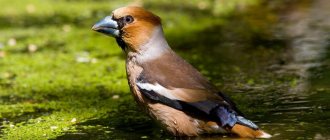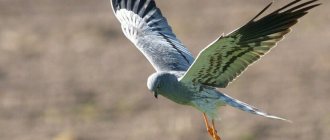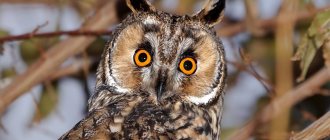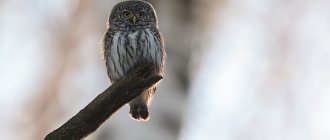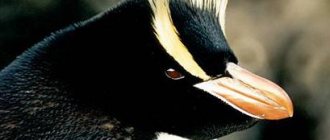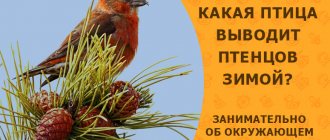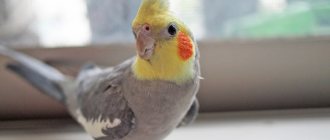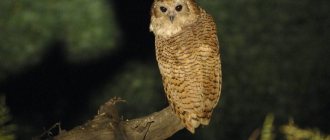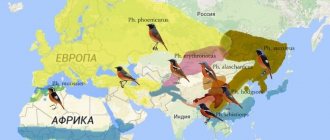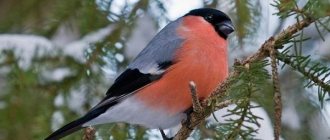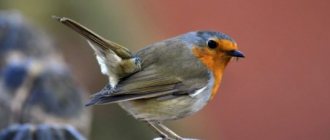- Wild animals
- >>
- Birds
If anyone doesn’t know, an owl is a miniature owl with a very attractive and pretty appearance. It is owls, most often, of all owls, that become pets, because They are small in size and caring for them is not that difficult. Let's try to understand the life activity of owls living in natural, wild conditions, describing their owl habits, habits, favorite places to live and characteristic external features.
Origin of the species and description
Photo: Sych
The owl is a bird belonging to the owl family and the order of owls. In Latin, the name of the bird sounds like “Athene”, which has a direct connection with the ancient Greek goddess of wars, Pallas Athena, who personifies wisdom. Owls and snakes were considered her faithful and reliable companions, so they were often depicted along with her appearance in various sculptures and paintings.
The name "owl" has Russian roots, is associated with the Proto-Slavic language and is associated with hissing, whistling and onomatopoeia. There are legends and signs about owls, sometimes not as noble and majestic as in Ancient Greece. Our ancestors believed that a meeting with an owl foreshadows trouble and adversity that could cause harm, both directly (to health) and indirectly (some person wishes evil).
Interesting fact: The owl looks quite serious and gloomy, his gaze is piercing and intent, it seems that the bird is in a bad mood and is frowning. It is quite possible that these features of the bird’s face gave rise to such unkind omens about these unusual winged predators.
Now in the genus of owls there are three bird species, which include:
- little owl;
- brahmin owl;
- rabbit owl.
Previously, there were many more varieties of owls, but they, unfortunately, became extinct, some several million years ago. Let us describe the characteristic features of species that have survived to our times. It is worth noting that there are different subspecies of these birds. The Brahmin owl can be called the smallest, its body length is about 21 cm, and its weight is 120 grams. The main tone of the feathers is grayish-brown with characteristic white patches.
Video: Owl
On the abdomen, on the contrary, there is a basic white color with brownish-gray specks. A white collar stands out on the neck. The calls of this bird are quite loud and resemble a grinding sound. The house owl is larger in size than the Brahmin owl, its length reaches a quarter of a meter, and the bird weighs about 170 grams. The feather color of this species is light brown; sand tones, decorated with white feathers, may predominate.
Interesting fact: This owl was nicknamed the brownie owl because... he often likes the attics of houses and barns. The bird does not shy away from human settlements, so it is often tamed.
Rabbit owls are distinguished by a reddish-brown color, on which a gray tone is slightly visible, but large streaks of white color stand out well. The chest and top of the abdomen are grayish-brown with some yellowness, the bottom of the belly is plain, yellow-white. The length of the bird's body can reach up to 23 cm. These owls are unusual in that they are active not only at night, but also during the daytime. The owl is considered a rabbit owl because it often makes nests in rabbit burrows.
Dimensions
These birds are not so small in size. The little owl, the photo of which you see in the article, weighs approximately 160-180 grams, its body length is 23-28 cm, its wings are 15-18 cm, and their wingspan is 57-64 cm.
As a rule, there are sexual differences, with females being slightly larger than males. Having met, two birds create a permanent pair and are together, even if the breeding season has not begun. They arrange nesting sites themselves, sometimes digging small holes or laying eggs in holes, in various buildings, and cliffs.
Appearance and features
Photo: What an owl looks like
If we compare owls with owls, the former are much smaller, their length is about 30 cm, and the birds weigh no more than two hundred grams. The common owl reaches a mass of 700 grams and a length of 65 cm. The owl's head is slightly flattened, while the owl's is rounded. The plumage of owls is dominated by white specks; the owl has clearly visible stripes on its feathers, located both lengthwise and across. Unlike owls, owls do not have feathered ears; in all other characteristics, these owls are very similar.
The owl's head is quite impressive in size, but what is most striking is its huge and piercing eyes, fixed in the sockets. When looking to the side, the owl has to turn its head. The iris of the eyes can be colored a deep yellow, golden or slightly yellowish hue, depending on the type of bird. Large round pupils in such a bright frame stand out well against the brownish or grayish color of the feathers. The sternness of the bird's gaze is given by supraorbital projections, reminiscent of human eyebrows, so frowning people are often asked the question: “Why are you looking like an owl?”
Interesting fact: Many people mistakenly believe that owls can turn their heads 360 degrees, this is not true, owls are able to look over their shoulders, turning their heads 135 degrees, but due to their flexible neck, the maximum rotation angle can reach 270 degrees.
The owl's tail is short, and the folded wings also look short. The birds have thick, dense plumage, usually of brown or sandy tones, which is diluted by chaotic whitish spots, so the owl appears pockmarked. The bird's belly is light with dark specks. The claws of a feathered predator can be called its weapons; they are long and sharp and have a dark brown, almost black color.
The beak tone can be:
- yellowish (from light to rich color);
- slightly greenish;
- yellow with a grayish admixture.
It has been noticed that the bird's mandible is often lighter than the mandible.
Sychik-elf
It is a tiny cinnamon colored owl with gray and white lines. Her eyes are large, yellow, and her beak is gray. The legs are without feathers, but covered with bristles. These amazing birds fly like bats, only more coordinated. They are not aggressive. They never engage in battle. They prefer to create nests in hollows. This bird's clutch contains no more than five eggs.
The Elf Owl absolutely cannot hunt due to its weak beak and weak paws. Their diet consists of various insects. The birds live in the USA and Mexico, where they settle in the trunks of saguaro cacti.
Where does the owl live?
Photo: Owl bird
The distribution area of owls is very extensive. Birds occupied Asia, Europe, the northern part of the African continent, and are found in the territories of the New World.
Feathered predators can be found in:
- forest areas;
- mountainous areas;
- semi-desert and desert areas;
- in an open flat area;
- next to a person.
Brahmin's owls have chosen South Asia; they give their preference to open forests and open areas with low bushes. This owl is often found in the territories of human settlements, settling near Calcutta and Delhi. The owl most often sets up its nesting sites in hollows, but can also settle in destroyed buildings, old abandoned buildings, and wall cavities. Owls often occupy other people's nests that have been abandoned by previous inhabitants (for example, Indian mynah starlings).
House owls occupy the vast expanses of Central and Southern Europe, the northern regions of the African continent and almost the entire Asian territory. They often live in open areas, inhabiting desert and semi-desert areas. For nesting, this owl chooses burrows, clusters of boulders, stumps with hollows and other secluded shelters. Rabbit owls inhabit both North and South America; the birds adore open areas with low-growing plants. Owls nest in rabbit holes and shelters of other large rodents.
Now you know where the owl lives. Let's see what she eats.
Bird distribution
— Advertising —
Sparrow owls are very widespread - on all continents, with the exception of Australia. A particularly large diversity of bird species is observed in South and Central America. Owls live in a variety of areas and climatic conditions - in the taiga, tropical forests and even deserts.
What does an owl eat?
Photo: Night owl
The owl is, first of all, a predator, therefore its diet consists of animal food, only it differs among different species and subspecies. It should be noted that the toes on bird feet are arranged in pairs, and these pairs are directed in different directions (forward and backward), this allows them to firmly grasp and hold prey. Birds do not have teeth, so they tear large victims into pieces, and immediately swallow small ones completely. Owl species differ not only in the different dishes on the menu, but also in their hunting tactics.
Owls hunt for large prey in pairs, acting together, because they may not be able to cope alone. Birds obtain smaller snacks one at a time. The little owl likes to eat voles, bats, jerboas, and hamsters. The bird will not refuse all kinds of insects and earthworms. This owl has a lot of patience while waiting for a victim; the attack occurs when the potential prey freezes and does not move. Hunting is carried out both by land and by air. The little owl is prudent and stores food.
Interesting fact: Owls spend a lot of time in burrows, hunting voles, so the plumage in the area of the head and spine often wears out, and only the bases of the feathers, similar to hedgehog needles, remain there.
The passerine subspecies of the owl prefers small birds and rodents. He does not swallow his victims whole, but carefully plucks them and selects only the most delicious things. This owl arranges its autumn reserves in hollows. The great-footed owl watches the situation from above, from an ambush, looking for a tasty snack, which is swallowed whole. Rodents and small birds are also preferred for him. The elf owl is classified as an insectivore; he likes to dine on grasshoppers, locusts, caterpillars, spiders, fly larvae, centipedes, and scorpions.
He always eats the caught prey in his shelter. An owl will not refuse frogs, lizards, toads, and dung beetles. The latter are simply adored by rabbit owls, who have come up with a cunning trick to lure these insects. Birds drag manure into their holes, which attracts victims who crawl into the lair of feathered predators.
Features of character and lifestyle
Photo: Owl
Owls can be confidently called sedentary birds, leading an active night life. Sometimes they can migrate a short distance, but, basically, they live permanently in the same place. Their vision and hearing are simply excellent, so night hunting is a success. Birds are inherently cautious and silent, so often potential victims have no idea that they will soon become a snack for winged predators.
Interesting fact: Rabbit owls are also characterized by daytime activity, while all other owl relatives hunt at night and in the pre-dawn hours.
During the day, almost all owls spend in their shelters, resting after night forays. These birds make lairs in various places.
For their homes, owls use:
- burrows;
- woodsheds;
- attics of buildings;
- hollows;
- wells;
- abandoned buildings;
- various antiquities and ruins;
- rocky crevices.
It is worth noting that some subspecies of these birds have dens in very exotic places.
Interesting fact: The Elf Owl, which inhabits North America, has a very flimsy beak, so it cannot hollow out a hollow itself; it often occupies empty nests and hollows of other birds. But its original place of residence is a hollow made in a huge cactus called a saguaro, which is very unusual.
Owls have an unsurpassed gift of camouflage; they can be heard, but are very difficult to see. Owl likes a secretive, spy life, so he is very careful about everything, especially meeting bipeds, whom he doesn’t trust. The cry of an owl in the night can instill fear and frighten, it is not for nothing that the bird is the hero of various frightening legends and beliefs. Based on various hunting methods and the habit of making pantries, owls can be called very smart, economical and prudent birds. If you do not pay attention to all the signs and superstitions, then it is quite possible to tame them and keep them at home.
Neutralization of negativity
- If an owl predicts something bad, throw a handful of salt into the fire and the prediction will burn.
- If trouble threatens your home, arm yourself with a red-hot poker and draw a line on the ground around your home, closing the path to trouble.
- If you absolutely want to place a scarecrow in one of the rooms, light 7 candles in each corner for three days in a row and let them burn to the end. Is buying almost a hundred candles out of your financial plans? Then at least wipe the windows and doors with the water in which the silver spoon has lain overnight, and wash the floor with a decoction of wormwood.
Social structure and reproduction
Photo: Owl bird
Owls become sexually mature when they are one year old. It’s not for nothing that we previously called them prudent, because they begin to look for a passion already with the arrival of February, and the wedding season begins only in the spring. The gentlemen lure the feathered ladies with their loud cries, then look after them, treating them to the caught delicacies.
Romantically inclined winged creatures stroke each other and lightly pinch each other with their beaks. After arranging the nesting site, the female begins to lay eggs, which can number from 2 to 5. Hatching begins from the moment the first egg is laid, so the chicks develop unevenly and, when they acquire normal plumage, often only one or two cubs remain alive, although the parents They treat them very carefully.
The female leaves from incubating her offspring only once a day, and even then, not for long. The rest of the time, the future feathered father takes care of her, bringing food and protecting her from ill-wishers. The male replaces his partner when she is away. The chicks hatch after a month, and the babies are born blind and covered with fluff.
After fledging, the babies live in their parents’ nest for approximately three weeks, during which time the parents instill in their offspring all the necessary hunting skills. The growth of birds occurs quite rapidly, so after a month they look like their mature relatives. The young animals gain full independence in August, setting off into adulthood, which in owls can last up to fifteen years.
Natural enemies of the owl
Photo: Owl in winter
Owls have plenty of enemies in natural wild conditions. Those birds that live near human settlements often suffer from ordinary cats; tropical feathered inhabitants are afraid of monkeys, which also often settle near cities. Various omnivorous, large birds (for example, ravens) pose a danger to owls. A raven can beat an owl to death with its beak. Various snakes pose a threat to chicks born in tree hollows.
Owls suffer greatly from the parasites that overwhelm them, both internal and external. It is the chicks infected with parasites that often die before they even fledge. Humans can also be counted among the enemies of owls, who often invade the habitats of the winged birds, displacing them from inhabited lands as a result of various economic activities, which negatively affects the bird’s life.
Owls behave with great caution around people, not allowing them to come close to them. If a person is still too close, then the frightened owl himself tries to scare the biped, swinging in different directions and bowing funny. Seeing such a dance is very hilarious, but it happens extremely rarely. If this intimidating dance maneuver has no effect and the enemy does not retreat, the owl takes off and hovers not far from the ground.
Population and species status
Photo: What an owl looks like
The distribution area of owls is quite large, and in some places their population is numerous and does not cause any concern, but not everywhere things are so favorable. Over the past decade, it has been noticed that the number of owls throughout Europe has noticeably decreased, this also applies to our country. Environmental organizations are concerned about this situation and are trying to take all necessary measures to stabilize the owl population.
Not one, but a number of factors negatively affect the numbers of these owls. Firstly, these are people who destroy natural biotopes, worsen the ecological situation, and occupy places where birds are permanently stationed for their own needs. Using various pesticides to irrigate cultivated fields, people kill many owls, which feed on field rodents.
Secondly, these are parasites that take away many birds’ lives, especially those that have recently been born. Thirdly, the lack of food in certain places (especially during the harsh winter period) greatly reduces the number of birds. Fourthly, the increase in the number of corvids greatly harms the owls. The whole set of these negative impacts leads to the fact that the number of owls is constantly declining, so in many regions they need special protection.

